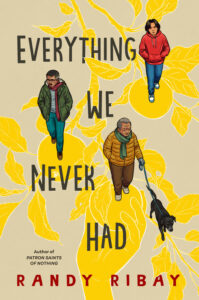 Review By: Sara Tripp
Review By: Sara Tripp
Published: 2024
Genre(s): Young Adult, Historical Fiction, Contemporary Fiction
Audience: Grades 7 to 12
Content Warnings: None listed
Goodreads Link: Everything We Never Had
Publisher’s Summary:
A novel about four generations of Filipino American boys grappling with identity, masculinity, and their fraught father-son relationships.
Watsonville, 1930. Francisco Maghabol barely ekes out a living in the fields of California. As he spends what little money he earns at dance halls and faces increasing violence from white men in town, Francisco wonders if he should’ve never left the Philippines.
Stockton, 1965. Between school days full of prejudice from white students and teachers and night shifts working at his aunt’s restaurant, Emil refuses to follow in the footsteps of his labor organizer father, Francisco. He’s going to make it in this country no matter what or who he has to leave behind.
Denver, 1983. Chris is determined to prove that his overbearing father, Emil, can’t control him. However, when a missed assignment on “ancestral history” sends Chris off the football team and into the library, he discovers a desire to know more about Filipino history―even if his father dismisses his interest as unamerican and unimportant.
Philadelphia, 2020. Enzo struggles to keep his anxiety in check as a global pandemic breaks out and his abrasive grandfather moves in. While tensions are high between his dad and his lolo, Enzo’s daily walks with Lolo Emil have him wondering if maybe he can help bridge their decades-long rift.
Review:
This multigenerational story offers an honest and powerful look at the immigrant experience through the lens of a Filipino American family across four generations.
What struck the reviewer most was the raw honesty in how each generation experiences America. The first generation arrives with hope, drawn by the American Dream, but faces racism and hardship that challenge any sense of belonging. The second generation grows up watching a father’s disappointments and tries to forge a new path rooted in hard work and success, even as understanding between father and son breaks down.
By the third generation, the family’s youngest man is fully Americanized, more focused on football than his Filipino roots—until life forces him to take a closer look at culture, heritage, and his family’s resilience. The fourth generation’s story, unfolding during the COVID 19 pandemic, is strikingly relatable. His emotional struggles, isolation, and identity questions will resonate with students who lived through similar experiences.
This book is a strong recommendation for high school classrooms because it invites meaningful conversations about family, culture, identity, immigration, generational conflict, and belonging. Students will see themselves reflected in these characters, and teachers will find rich connections to modern American history and social issues. It is ideal for classes focused on identity, multicultural literature, or contemporary history.



